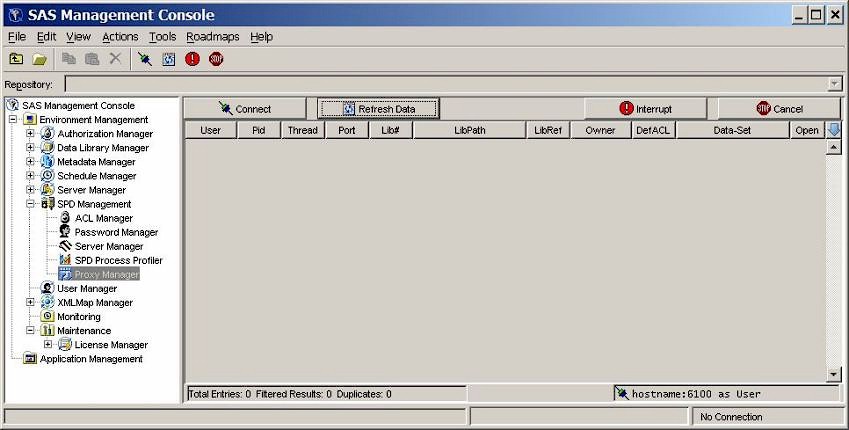Proxy Manager
Overview of the Proxy Manager
The SAS
Management Console tree for SPD Server contains a folder called Proxy
Manager. You use the Proxy Manager to display tables that list all
users that access a specific SPD Server host. The current libref
allocations are displayed for each user, as well as information about
the proxy that serves each libref. Available proxy information includes
the process ID, the port number, the library path, and if the libref
was established with record locking, the thread ID. For each allocated
libref, you can view every data set that is accessible to or open
in the libref. If a libref was established with ACL special privileges,
then all data sets in the specified domain are visible and accessible
to that libref, regardless of any connection settings that are established
through the SPD Management utilities in the SAS Management Console.
Before
you can perform any operations in the Proxy Manager, you must be connected
to an SPD Server host. The section Connecting to an SPD Server provides detailed instructions on connecting to an SPD
Server host. After you connect to an SPD Server host, click Refresh Data in the Proxy Manager to update the view
on the table data.
You can
filter, sort, reorder, and hide Proxy Manager table columns to display
proxies of interest. You perform filtering and sorting by clicking
on the column headings and selecting the appropriate choice from the
menu.
Proxy Refresh
Click Refresh Data to update the table with the most current
proxy data. Refreshing is necessary after an initial connection or
after a proxy state has been manipulated. Because a proxy's state
is dynamic, each refresh provides only an instantaneous snapshot of
the proxies. Data status can change immediately after the data is
refreshed, which is the nature of a dynamic client/server environment.
If no users are currently logged on to the server, a window displays
the message.
Proxy Interrupt
Click Interrupt to interrupt a selected libref's proxies.
The proxy's activity is halted when it next processes data from its
socket. The frequency with which the proxy accesses its socket is
unpredictable and can vary depending on many variables, but the proxy
interrupt operation is normally the first method used to halt a proxy
from accessing a given data set or domain.
Proxy Cancel
Click Cancel to cancel all proxies in the selected libref.
The proxy's activity is immediately halted, and any open data connections
are immediately closed. Clicking Cancel to
stop a proxy from accessing a data set or a given domain is recommended
when the interrupt operation is unacceptably delayed.
